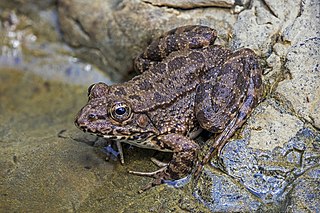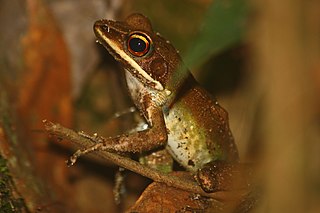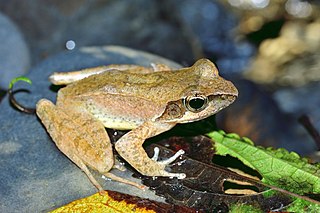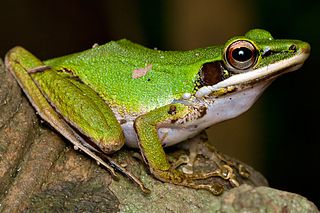
True frogs is the common name for the frog family Ranidae. They have the widest distribution of any frog family. They are abundant throughout most of the world, occurring on all continents except Antarctica. The true frogs are present in North America, northern South America, Europe, Africa, and Asia. The Asian range extends across the East Indies to New Guinea and a single species, the Australian wood frog, has spread into the far north of Australia.

Amnirana is a genus of frogs in the family Ranidae, "true frogs". The genus is primarily found in Sub-Saharan Africa, but one species occurs in parts of southern and southeastern Asia. Some of the African species are widespread but contain undescribed cryptic diversity. Most species have a white upper lip, and the genus is sometimes known as the white-lipped frogs.

Amolops is a genus of true frogs native mainly to eastern and south-eastern Asia. These frogs are closely related to such genera as Huia, Meristogenys, Odorrana, Pelophylax and Rana, but still form a distinct lineage among the core radiation of true frogs. They are commonly known as "torrent frogs" after their favorite habitat - small rapid-flowing mountain and hill streams - but this name is used for many similar-looking frogs regardless of whether they are loosely related.

Indosylvirana aurantiaca, commonly known as the golden frog, is a species of frog endemic to the Western Ghats of India. The species is also known as the Trivandrum frog, the common wood frog, or the small wood frog.

The common green frog is a frog species of in the true frog family Ranidae; some sources still use the old name Rana erythraea. It lives in Southeast Asia and is also known as green paddy frog, red-eared frog or leaf frog. The last name, however, commonly refers to the Neotropical tree frogs which make up the subfamily Phyllomedusinae. These are not closely related to H. erythraea, belonging to family Hylidae instead.

Sylvirana faber is a species of frog in the family Ranidae. It is found in Cambodia and possibly Thailand.

Hylarana garoensis, commonly known as Boulenger's Garo hill frog, Daniel's frog, Swift cascade frog, Garo's hill frog or the Mawphlang frog, is a accepted species of frog in the family Ranidae. H. garoensis' natural habitats are subtropical or tropical moist lowland forests, subtropical or tropical moist shrubland, subtropical or tropical high-altitude grassland, and rivers; it is found in India and possibly Bangladesh. It is threatened by habitat loss.

Hylarana guentheri is a species of frog in the family Ranidae. It was formerly placed in the genus Rana. It is found in China, Hong Kong, Macau, Taiwan, Vietnam, and possibly Cambodia and Laos. An introduced population is found on Guam. It can live as high as 1100 meters above sea level. An alternate common name is Günther's Amoy frog, and the honorific is often spelled "Guenther's".

Rana sauteri is a species of true frog endemic to Taiwan. It inhabits low-altitude hill forests and the associated streams. It is an endangered species threatened by habitat loss due to agriculture and infrastructure development. Common names recorded for Rana sauteri include Kanshirei Village frog, Taiwan groove-toed frog, Sauter's brown frog, and Taiwan pseudotorrent frog.

Humerana lateralis is a species of frog in the family Ranidae. It is found in Cambodia, Laos, Myanmar, Thailand, and Vietnam. It is commonly known as Kokarit frog, yellow frog or (ambiguously) wood frog.

Hylarana latouchii, also known as Kuatun frog, La Touche's frog, or broad-folded frog, is a species of frog in the family Ranidae. It was formerly placed in genus Rana. The specific name honours the collector of the type series: "Hylarana" latouchii was described by George Albert Boulenger based on three specimens collected by Irish ornithologist John D. La Touche in Guadun village in Wuyishan, Fujian, China.

Chalcorana labialis, also known as the white-lipped frog, is a species of "true frog" in the family Ranidae. As currently known, it is endemic to Peninsular Malaysia, although it might also occur in Singapore. Molecular data suggest presence of three distinct lineages in the same area, one of which is not closely related to Chalcorana labialis and which could represent an unnamed species.

Hylarana, commonly known as golden-backed frogs, is a genus of true frogs found in tropical Asia. It was formerly considered highly diverse, containing around 84 to 96 valid species, but taxonomic revision resulted in a major change in the contents of the genus, recognizing just four species.

Chalcorana is a genus of frogs in the family Ranidae, "true frogs". They are found in Southeast Asia, from Thailand to Malay Peninsula and the Sunda Islands.

Papurana is a genus of frogs in the family Ranidae, "true frogs". They are known from Southeast Asia, New Guinea, and northern Australia. Papurana daemeli is the only ranid frog found in Australia.

Papurana florensis is a species of true frog. It is native to the islands of Lombok, Sumbawa, and Flores in Indonesia. Common names Floresian frog and Flores frog have been coined for it.

Papurana papua is a species of true frog, family Ranidae. It is endemic to New Guinea and found in the northern part of the island in both Indonesia and Papua New Guinea as well in some offshore islands. Common name Papua frog has been coined for it.
Hylarana spinulosa, also known as fine-spined frog and spiny frog, is a species of true frog, family Ranidae. It is endemic to Hainan, southern China. It occurs in tropical forests at elevations of 80–840 m (260–2,760 ft) above sea level. Breeding takes place in pools and slow-flowing streams.
Sylvirana roberti, the Tenaserim dark-side frog or Robert's dark-side frog, is a frog in the family Ranidae. It is endemic to peninsular Myanmar. Scientists believe it may also live in Thailand.

Hylarana malayana, the Malaya stream frog, Malay woodfrog, or Malayan dark-side frog, is a frog in the family Ranidae. It is endemic to Myanmar and India.


















